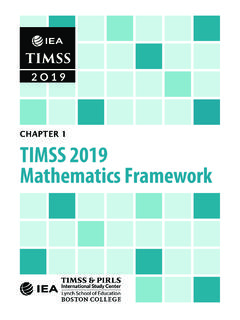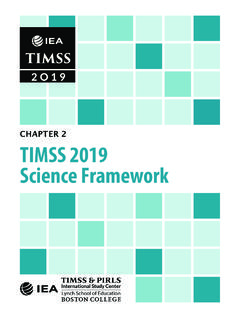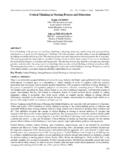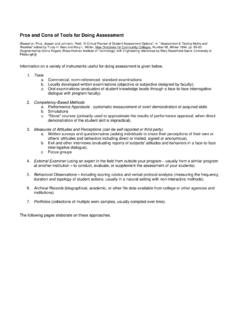Transcription of Assessment Frameworks - TIMSS 2019 International Results ...
1 Ina MullisMichael O. Martin,EditorsAssessment TIMSS 2019 FrameworksTIMSS & PIRLSL ynch School of EducationInternational Study CenterTIMSS 2019 Assessment FrameworksTIMSS & PIRLSL ynch School of EducationInternational Study CenterIna MullisMichael O. Martin,EditorsCopyright 2017 International Association for the Evaluation of Educational Achievement (IEA) TIMSS 2019 Assessment FrameworksIna Mullis and Michael O. Martin, EditorsPublishers: TIMSS & PIRLS International Study Center,Lynch School of education , Boston CollegeandInternational Association for the Evaluation of Educational Achievement (IEA)Library of Congress Catalog Card Number: 2017951157 ISBN: 978-1-889938-41-7 For more information about TIMSS contact: TIMSS & PIRLS International Study CenterLynch School of EducationBoston CollegeChestnut Hill, MA 02467 United Statestel: +1-617-552-1600fax: +1-617-552-1203e-mail: College is an equal opportunity, affirmative action & PIRLSL ynch School of EducationInternational Study Center TIMSS 2019 Assessment Frameworks iIntroduction.
2 1 Ina MullisChapter 1 TIMSS 2019 Mathematics framework .. 11 Mary Lindquist, Ray Philpot, Ina Mullis, Kerry E. CotterChapter 2 TIMSS 2019 Science framework ..27 Victoria Centurino, Lee R. JonesChapter 3 TIMSS 2019 Context Questionnaire framework .. 57 Martin Hooper, Ina Mullis, Michael O. Martin, Bethany FishbeinChapter 4 TIMSS 2019 Assessment Design .. 79 Michael O. Martin, Ina Mullis, Pierre FoyAppendix AAcknowledgments ..93 Appendix BExample Restricted Use Items .. 103 TIMSS & PIRLSL ynch School of EducationInternational Study CenterIntroductionTIMSS 2019 Assessment FrameworksTIMSS & PIRLSL ynch School of EducationInternational Study Center TIMSS 2019 Assessment Frameworks : INTRODUCTION 3 IntroductionIna MullisTIMSS 2019: Monitoring Trends in Mathematics and Science AchievementEntering into its third decade and seventh cycle of data collection, TIMSS (Trends in International Mathematics and Science Study) is a well established International Assessment of mathematics and science at the fourth and eighth grades.
3 TIMSS 2019 is the most recent in the TIMSS trend series, which began with the first assessments in 1995 and continued every four years 1999, 2003, 2007, 2011, 2015, and 2019. About 60 countries use TIMSS trend data for monitoring the effectiveness of their educational systems in a global context, and new countries join TIMSS in each cycle. About 70 countries are expected to participate in TIMSS a mathematics and science Assessment , TIMSS is a valuable resource for monitoring educational effectiveness because science, technology, engineering, and mathematics, often known as STEM, are key curriculum areas. It is clear that even today many jobs require a basic understanding of mathematics and science, and this will become increasingly so in the future.
4 Workers in STEM occupations are responsible for finding solutions to world problems such as hunger and disappearing habitats as well as sustaining growth and stability in the global economy. Mathematics and science also are basic to daily life. Science is the natural world, including our weather, land and water, and sources of food and fuel. Mathematics helps us manage a host of daily tasks and is essential in developing the technology we depend on, such as computers, smartphones, and mathematics and science pervade every aspect of our lives, the International Association for the Evaluation of Educational Achievement, more widely known as IEA, has been conducting International assessments of mathematics and science for nearly 60 is an independent International cooperative of national research institutions and government agencies that has been conducting studies of cross-national achievement since 1959.
5 IEA pioneered International comparative Assessment of educational achievement in the 1960s to gain a deeper understanding of policy effects across countries different systems of education . Today, IEA s Amsterdam office manages country participation in a number of International studies, and IEA s Hamburg division is a large data processing and research center. As a major program of IEA, TIMSS has the benefit of drawing on the cooperative expertise provided by representatives from countries all around the & PIRLSL ynch School of EducationInternational Study Center TIMSS 2019 Assessment Frameworks : INTRODUCTION 4 TIMSS is directed by the TIMSS & PIRLS International Study Center in the Lynch School of education at Boston College.
6 TIMSS and PIRLS (Progress in International Reading Literacy Study), an International Assessment of reading, together comprise IEA s core cycle of studies measuring achievement in three fundamental subjects mathematics, science, and Relevant Data About the Content and Contexts for Learning Mathematics and ScienceTIMSS uses the curriculum, broadly defined, as the major organizing concept in considering how educational opportunities are provided to students and the factors that influence how students use these opportunities. The TIMSS Curriculum Model has three aspects: the intended curriculum, the implemented curriculum, and the attained curriculum (see Exhibit 1).
7 These represent, respectively, the mathematics and science that students are expected to learn as defined by countries curriculum policies and publications and how the educational system should be organized to facilitate this learning; what is actually taught in classrooms, the characteristics of those teaching it, and how it is taught; and, finally, what it is that students have learned and what they think about learning these 1: TIMSS Curriculum ModelIntendedCurriculumNational, Socialand EducationalContextsHome, School, Teacher, and Classroom Contexts StudentAchievement and AttitudesImplementedCurriculumAttainedCu rriculumTIMSS & PIRLSL ynch School of EducationInternational Study Center TIMSS 2019 Assessment Frameworks : INTRODUCTION 5 Working from this model, TIMSS routinely publishes the TIMSS Encyclopedia with each Assessment to document education policies and the curriculum in mathematics and science in each of the participating countries.
8 The TIMSS 2015 Encyclopedia: education Policy and Curriculum in Mathematics and Science (Mullis, Martin, Goh, & Cotter, 2016) provides an important resource for helping to understand the teaching and learning of mathematics and science around the world, with particular emphasis on schooling through the eighth grade. A chapter prepared by each country and benchmarking participant summarizes the structure of its education system , the mathematics and science curricula instruction in the primary and secondary grades, the teacher education requirements, and the types of examinations and assessments employed. To provide standard information across countries that supplements the chapters, countries complete a curriculum questionnaire about their mathematics and science curricula, school organizational approaches, and instructional also asks students, their parents or caregivers, their teachers, and their school principals to complete questionnaires about their home and school experiences and instructional contexts for learning mathematics and science.
9 The questionnaires are developed according to a carefully developed framework that is updated with each Assessment through iterative reviews by the TIMSS National Research Coordinators and the TIMSS Questionnaire Item Review Committee of International experts. Data from these questionnaires provide a dynamic picture of the implementation of educational policies and practices that can raise important issues and suggest avenues for educational 3 of this volume contains the TIMSS 2019 Context Questionnaire framework . TIMSS 2019 will concentrate on measuring trends for the existing context questionnaire scales and developing several new context questionnaire scales that address emerging areas of research in educational TIMSS International Assessments in Mathematics and ScienceThe TIMSS International assessments of mathematics and science were inaugurated in 1995 as a follow-up to IEA s earlier studies conducted separately in these curriculum areas (two in mathematics and two in science) during the 1960s through the 1980s.
10 After the early Assessment cycles in the 1990s, TIMSS has been stable over the next two decades with regular assessments every four years at the fourth and eighth grades. Since 1995, the achievement Results of each TIMSS Assessment (mathematics and science, fourth and eighth grades) have been reported on achievement scales that span the Assessment cycles, making it possible to detect changes in achievement from one cycle to the next, and to measure trends in achievement over time. In addition, assessing fourth and eighth grades provides a quasi-cohort design with the fourth grade student cohort assessed in one cycle becoming the eighth grade student cohort assessed in the next cycle.










